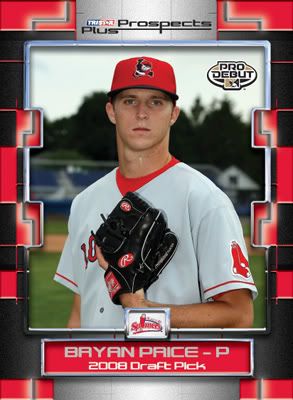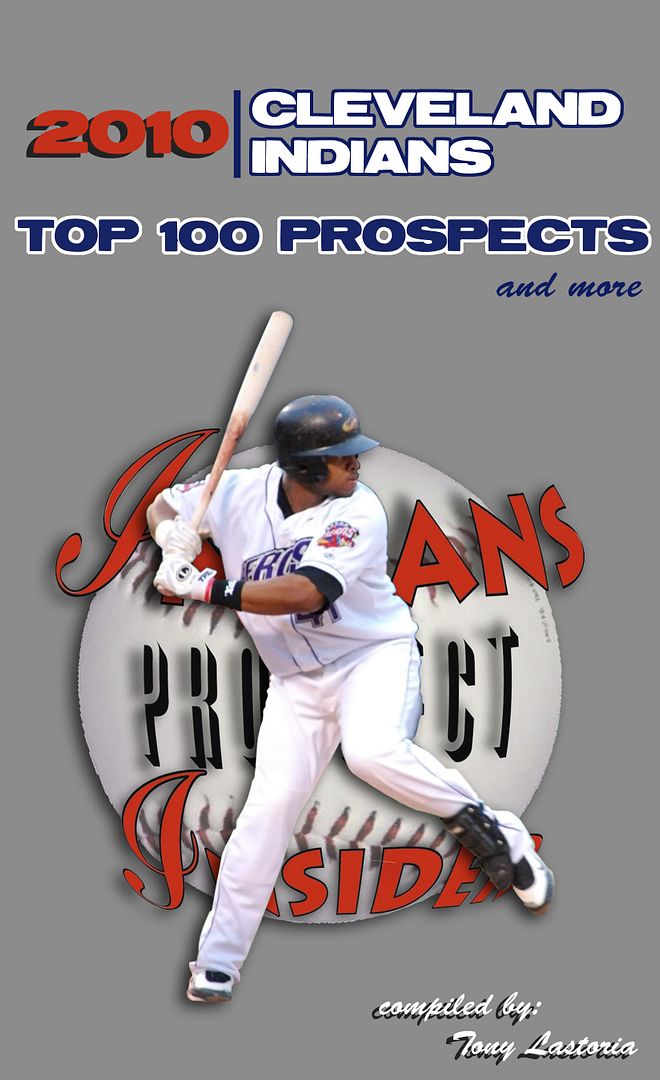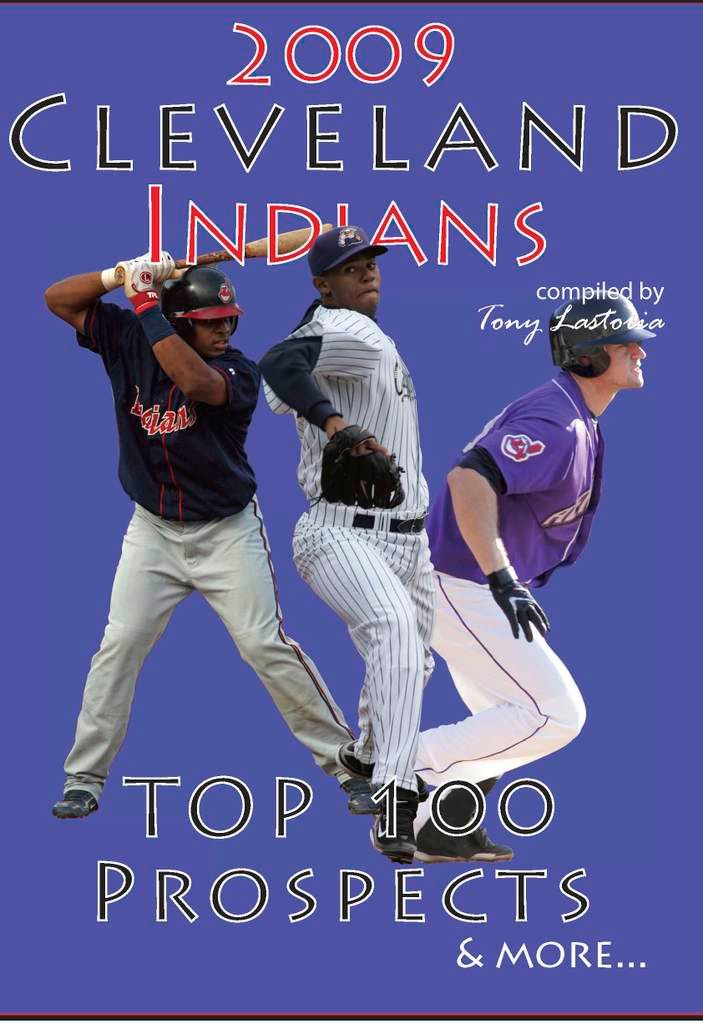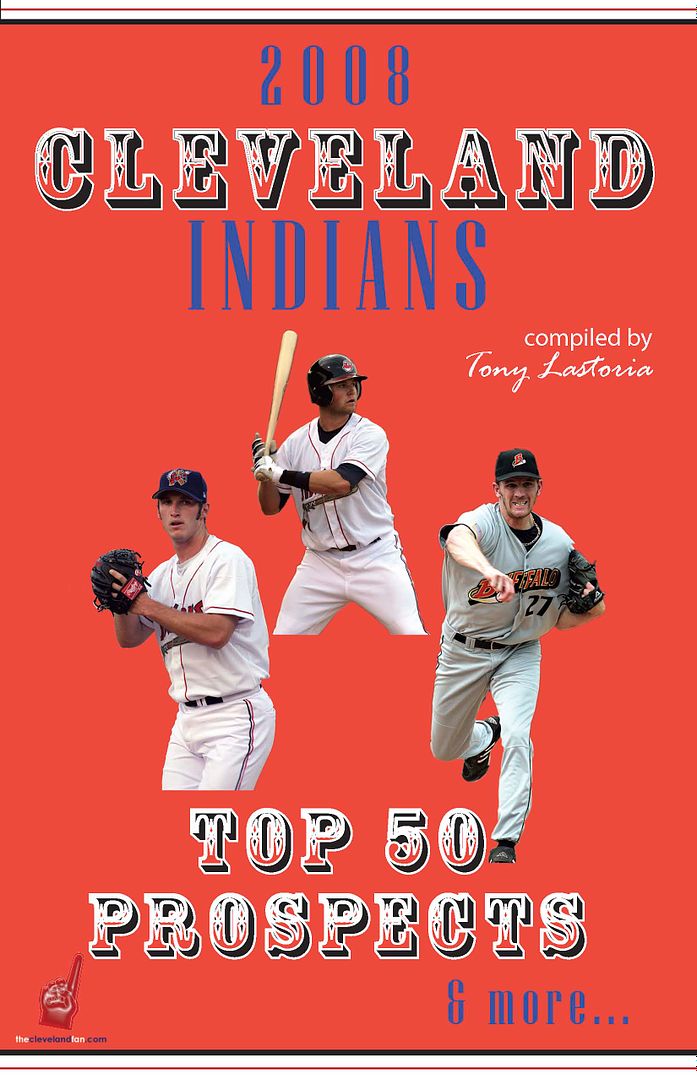 Welcome back for another Diamonds in Single A article. For the next few weeks this space will be focusing on all of the players the Indians have acquired in trades this year. Last week we focused on the first new young arm, Connor Graham. This week we will focus on the least talked about pitcher from the deals – Bryan Price. Unlike the rest of the new arms, Price was not the feature piece in his trade so he has not been talked about as much. Thus, it seemed only fair to put the spotlight on him this week.
Welcome back for another Diamonds in Single A article. For the next few weeks this space will be focusing on all of the players the Indians have acquired in trades this year. Last week we focused on the first new young arm, Connor Graham. This week we will focus on the least talked about pitcher from the deals – Bryan Price. Unlike the rest of the new arms, Price was not the feature piece in his trade so he has not been talked about as much. Thus, it seemed only fair to put the spotlight on him this week.
Price was a first round pick of the Red Sox last year out of Rice. He was selected in the supplemental round, picked 45th overall. He was a closer for Rice in college, but the Red Sox decided to make him a starter. He didn’t pitch a ton of innings in college since he worked from the pen and had very little mileage on his arm. He has a ¾ delivery and features a fastball and a slider, which is his out pitch. He is working on a change up but it’s still a work in progress. He throws both a four seam and a two seam fastball. The four seam has higher speeds, but the two seam seems to have better movement. His four seam fastball sits in the mid 90’s, but when Price has worked in the pen his fastball has hit the high 90’s. This has caused some debate as to whether or not the pen is where his future should lie. His two seam fastball sits in the low 90’s but as noted has shown good movement away from hitters. The slider gives him a nice change of pace and sits in the mid 80’s, giving good separation from his fastball. The change is a bit all over the place and still needs work in terms of consistency.
Year Level WHIP SO/9 BB/9 ERA H/9 HR/9 SO/BB BABIP
2008 A_SS 1.43 9.7 2.2 3.82 10.6 .4 4.3 .394
2009 A-/A+ 1.35 9.1 2.9 4.67 9.2 .6 3.13 .294/.390
This week I have added a new stat, BABIP. It stands for batting average of balls put into play. It’s a great stat to explain a pitcher’s sudden turn around when there seems to be no reason for the change. It’s the red flag stat for a pitcher whose rates are too high or too low. If a rate is too extreme it is impossible to maintain and tends to balance out. The typical BABIP is 290. You should also note that I split the data from his two levels of pitching because composite data doesn’t work as well with BABIP. I added this because I wanted to show that Price’s hit rate is awful but also seems to be partially thanks to bad luck. He could be the rare pitcher who has a very high BABIP, but the odds of that are very low. In spite of a high hit rate, Price’s WHIP’s have still been solid. So once his hit rate balances out, his WHIP should become great. His walk rates are solid for a young pitcher, and by all scouting reports Price has shown very good command. This is very encouraging because, as always, control seems to be the major issue in younger pitchers.
His stats also show how ERA can be very deceiving. In many ways his numbers have stayed even, and yet his ERA has jumped. His WHIP has gotten noticeably smaller, but just as noticeably his ERA jumped. This is another indicator that his BABIP will drop along with his hit rate as the year goes on. The rest of his stats show he should have more of a mid 3 ERA, and I expect by the end of the year he will be closer to 3 then 5.
Going forward there will be talk about what is the right move for Price: should he move back to the pen where he pitched in college? Or will his pitches develop and allow him to stay in the rotation? In my non expert opinion, I see him as a starter down the road. His change up may only be making slow progress, but it’s progress all the same. It doesn’t need to be a dominant pitch, just something to help set up his fastball. He should be a middle of the rotation type of starter with number 2 potential. Going forward I am curious to see how his numbers balance. Price is another young fireballer who should help this team in a few years.
skip to main |
skip to sidebar
 Everything on this site is free, but for those interested in making any monetary contributions to help support the stability and growth of this site please click on the "Donate" button below.
Everything on this site is free, but for those interested in making any monetary contributions to help support the stability and growth of this site please click on the "Donate" button below.
- Forum
- Affiliates
- Draft
- Stats
- Transactions
- Reference
- Rankings
- Depth Chart
- Payroll
Available IPI Books
IPI's Breaking Newswire
Support the IPI!
 Everything on this site is free, but for those interested in making any monetary contributions to help support the stability and growth of this site please click on the "Donate" button below.
Everything on this site is free, but for those interested in making any monetary contributions to help support the stability and growth of this site please click on the "Donate" button below.
Labels
- 1968 cleveland indians (3)
- 1981 Draft (1)
- 1982 Draft (1)
- 1983 Draft (1)
- 1984 Draft (1)
- 1985 Draft (1)
- 1986 Draft (1)
- 1987 Draft (1)
- 1988 draft (2)
- 1989 Draft (1)
- 1990 Draft (1)
- 1991 Draft (1)
- 1991 indians (1)
- 1992 Draft (1)
- 1993 Draft (1)
- 1993 indians (1)
- 1994 Draft (1)
- 1995 draft (1)
- 1996 draft (1)
- 1997 Draft (1)
- 1998 Draft (1)
- 1998 indians (1)
- 2003 indians (1)
- 2008 Transactions (1)
- 2009 Playoff Stats (2)
- 2009 Spring Training Games (20)
- 2009 Transactions (1)
- 2010 Draft (11)
- 2010 Instructional League (20)
- 2010 Prospect Book (8)
- 2010 spring training games (19)
- 2010 Transactions (1)
- 2011 Arizona Fall League (41)
- 2011 Champions (1)
- 2011 Draft (13)
- 2011 Draft News (29)
- 2011 Instructional League (29)
- 2011 organizational reports (4)
- 2011 Playoffs (5)
- 2011 prospect book (13)
- 2011 ranking (1)
- 2011 spring training (7)
- 2011 Transactions (5)
- 2012 Book (1)
- 3 up 3 down (3)
- A.J. Cole (1)
- Aaron Cunningham (3)
- Aaron Fields (2)
- Aaron Harang (2)
- Aaron Holbert (5)
- Aaron Laffey (13)
- Aaron Siliga (1)
- Abel Guerrero (5)
- Abner Abreu (55)
- Adam Abraham (25)
- Adam Davis (11)
- Adam Everett (5)
- Adam Griffin (1)
- Adam Miller (79)
- Adam White (6)
- AFL (1)
- Aflac (1)
- Akron (28)
- albie lopez (1)
- Alex Escobar (1)
- Alex Gonzalez (1)
- Alex Kaminsky (2)
- Alex Lavisky (15)
- Alex Monsalve (4)
- Alex White (66)
- Alexander Perez (32)
- Alexander Torres (1)
- all-star game (1)
- Allen Craig (2)
- Anderson Hernandez (6)
- Andrew Humphries (2)
- Andrew Means (1)
- Andrew Shive (3)
- Andrew Triggs (2)
- Andruw Jones (3)
- Andy Cannizaro (1)
- andy gonzalez (1)
- Andy LaRoche (1)
- Andy Marte (23)
- Aneury Rodriguez (1)
- Anillins Martinez (2)
- Anthony Gallas (7)
- Anthony Reyes (25)
- Anthony Santander (2)
- Antwonie Hubbard (3)
- Aramis Ramirez (1)
- arbitration (1)
- Argenis Martinez (6)
- Argenis Reyes (3)
- Arizona Fall League (15)
- Arizona League (3)
- Arizona Parallel League 2009 (10)
- Armando Camacaro (1)
- Around the Farm (356)
- Asdrubal Cabrera (28)
- Austin Adams (27)
- Austin Diemer (1)
- Austin Kearns (16)
- awards (9)
- AZL Indians (4)
- B.J. Upton (5)
- Barret Loux (1)
- Bartolo Colon (2)
- Baseball America (7)
- Baseball Prospectus (2)
- Beau Mills (65)
- Ben Carlson (5)
- Ben Copeland (2)
- Ben Francisco (9)
- Ben Holmes (1)
- Ben Lively (1)
- Ben Wetzler (1)
- Bert Blyleven (2)
- Betancourt (1)
- Billy Traber (1)
- Blaine Neal (1)
- Blaine O'Brien (4)
- Bo Greenwell (29)
- Bob Feller (2)
- Bobby Livingston (3)
- Bobby Valentine (2)
- Bobby Wahl (2)
- Book (6)
- Brad Grant (4)
- Brad Hinkle (1)
- Brad Snyder (8)
- brandon phillips (2)
- Brandon Pinckney (1)
- breaking news (51)
- Brett Brach (16)
- Brett Wallace (1)
- Brian Barton (10)
- Brian Bixler (6)
- Brian Buscher (1)
- Brian Grening (1)
- Brian Hansen (1)
- Brian Heere (2)
- Brian Horwitz (1)
- Brian Juhl (5)
- Brian Ruiz (3)
- Brian Slocum (5)
- Brock Simpson (3)
- Brock Stassi (2)
- Bryan Price (17)
- Bryce Brentz (1)
- Bryce Harper (1)
- Bryce Stowell (42)
- Bryson Myles (12)
- Bryson Smith (1)
- Bubba Bell (2)
- Bubbie Buzachero (1)
- buddy bell (1)
- Buffalo Bisons (3)
- bullpen (1)
- Burch Smith (2)
- Carl Pavano (1)
- Carlos Beltran (3)
- Carlos Carrasco (45)
- Carlos Lee (3)
- Carlos Moncrief (10)
- Carlos Pena (4)
- Carlos Rivero (33)
- Carlos Santana (76)
- Carlton Smith (21)
- Carolina Mudcats (4)
- Casey Blake (1)
- Casey Frawley (8)
- Casey Kotchman (9)
- CBA (1)
- CC Sabathia (2)
- Chad Durbin (3)
- Chad Huffman (12)
- chad paronto (1)
- Chad Rodgers (1)
- Charles Nagy (4)
- Chase Burnette (6)
- Chen-Chang Lee (24)
- Chin-Lung Hu (1)
- Chris Kersten (4)
- Chris Antonetti (6)
- Chris Archer (7)
- Chris Gimenez (41)
- Chris Heisey (2)
- Chris Iannetta (1)
- Chris Jones (13)
- chris magruder (1)
- Chris Nash (10)
- Chris Perez (10)
- Chris Ray (1)
- Chris Sale (1)
- Chris Seddon (1)
- Chris Tremie (2)
- Christian Colon (1)
- Christian Powell (1)
- Christopher Beck (1)
- Christopher Bradford (1)
- Christopher Waylock (2)
- Chuck Galeti (1)
- Chuck Lofgren (65)
- chun (1)
- Chun-Hsiu Chen (40)
- Cirilo Cumberbatch (2)
- Clayton Cook (20)
- Clayton Cook blog (1)
- Clayton Ehlert (1)
- Cleveland Cavaliers (1)
- Cleveland Indians (46)
- cliff lee (9)
- Clip and Dirty (29)
- Coaching staff (4)
- Coaching Staffs (1)
- Cody Allen (8)
- Cody Anderson (3)
- Cody Bunkelman (1)
- Cody Elliott (3)
- Cole Cook (6)
- Cole Pitts (2)
- Columbus (66)
- Connor Graham (19)
- Cord Phelps (62)
- Corey Embree (2)
- Corey Kluber (21)
- Cory Burns (29)
- Cory Embree (1)
- Cristo Arnal (1)
- Dale Dickerson (1)
- Dallas Cawiezell (8)
- Damaso Espino (3)
- Dan Cevette (5)
- Dan DeGeorge (1)
- Dan Wheeler (3)
- Daniel Jimenez (3)
- Daniel Morales (1)
- Danny Salazar (14)
- Dante Gentile (1)
- danys baez (1)
- Dave DeFreitas (1)
- Dave Hudgens (2)
- Dave Miller (4)
- Dave Wallace (1)
- david bell (1)
- David Goforth (1)
- David Huff (50)
- david riske (1)
- David Roberts (5)
- David Wright (1)
- Delvi Cid (12)
- Demarcus Tidwell (1)
- denis boucher (1)
- Denny Montero (1)
- Depth chart (7)
- Derek Lowe (4)
- Derrek Lee (4)
- Detroit Tigers (2)
- Dick Jacobs (2)
- Diego Seastrunk (3)
- Dillon Howard (10)
- Dillon Peters (7)
- Dioris Robles (1)
- Dominican Summer League (3)
- Donnie Webb (14)
- Dorssys Paulino (2)
- Doug Mathis (2)
- Doug Pickens (7)
- Draft (1)
- Draft History (1)
- Draft Retrospective (1)
- Drew Pomeranz (51)
- Drew Rucinski (1)
- Drew Sutton (3)
- DSL (1)
- DSL Indians (4)
- Dustin Realini (5)
- Dwight Childs (3)
- Earl Snyder (1)
- Eddie Burns (4)
- Eddie Mujica (4)
- Edgar Pineda (1)
- Eduardo Perez (1)
- Edward Salcedo (5)
- Edwin Rodriguez (2)
- Elliot Johnson (1)
- Ellis Burks (1)
- Elvis Araujo (14)
- Eric Berger (36)
- Eric Chavez (1)
- Eric Haase (5)
- Eric Wedge (2)
- Erik Stiller (16)
- Estevenson Encarnacion (1)
- Evan Frazar (2)
- Ezequiel Carrera (20)
- Fausto Carmona (20)
- felix fermin (1)
- Felix Pie (3)
- Felix Sterling (7)
- Francisco Jimenez (6)
- Francisco Lindor (11)
- Francisco Miguel (1)
- Francisco Valera (1)
- Frank DeJiulio (2)
- Frank Herrmann (31)
- Fred Lewis (2)
- Gaby Sanchez (3)
- Game Recaps (45)
- Garrison Campfield (3)
- General Minor League Info (2)
- Geoffrey Davenport (3)
- ghosts of prospects past (7)
- Gibson (1)
- Gio Gonzalez (1)
- Giovanni Soto (21)
- Giovanny Urshela (10)
- Goodyear (1)
- Grady Sizemore (33)
- Grant Sides (4)
- Greg Aquino (1)
- Greg Folgia (7)
- Greg Hibbard (1)
- Gregorio Petit (3)
- Gregorio Rosario (3)
- Gregory Folgia (3)
- hank peters (1)
- Hanley Ramirez (1)
- Harmon Killebrew (1)
- Harold Guerrero (1)
- Heath Taylor (3)
- Hector Ambriz (14)
- Hector Lunar (1)
- Hector Rondon (68)
- Henry Dunn (2)
- Hiroki Kuroda (3)
- Hitoshi Tamura (2)
- howard (1)
- Hunter Jones (3)
- Hunter Pence (2)
- indians (2)
- Indians Minor League Magazine (39)
- indians prospect (1)
- Instructional League (2)
- Instructional League 2009 (12)
- International Signing Period (4)
- IPI Inbox (1)
- Isaias Velazquez (4)
- J.D. Martin (12)
- J.D. Reichenbach (1)
- J.D. Reichenback (1)
- Jack Cassell (1)
- Jack Hannahan (8)
- Jack Wagoner (3)
- Jae Kuk Ryu (1)
- Jake Lowery (11)
- Jake McGee (1)
- Jake Sisco (5)
- Jake Westbrook (7)
- James Jones (1)
- James Taillon (1)
- Jamey Wright (2)
- Jared Goedert (49)
- Jared Ruxer (2)
- Jason Bere (1)
- Jason Cooper (4)
- Jason Davis (3)
- Jason Denham (1)
- Jason Donald (34)
- Jason Grilli (1)
- Jason Kipnis (65)
- Jason Knapp (39)
- Jason Kubel (1)
- Jason Rice (1)
- Jason Smit (15)
- jay bell (1)
- Jay Gause (1)
- Jayson Nix (7)
- JD Goryl (1)
- Jeanmar Gomez (48)
- Jeff Desjardins (1)
- Jeff Francoeur (2)
- Jeff Harris (1)
- Jeff Hehr (2)
- Jeff Johnson (4)
- Jeff Moorad (1)
- jeff mutis (1)
- Jeff Rowland (1)
- Jeff Shaus (1)
- Jeff Stevens (21)
- Jensen Lewis (12)
- Jer (1)
- Jerad Head (29)
- Jeremie Tice (14)
- Jeremy Accardo (2)
- Jeremy Bonderman (1)
- Jeremy Johnson (3)
- Jeremy Sowers (13)
- Jerrod Riggan (1)
- Jerrud Sabourin (2)
- Jess English (1)
- Jess Todd (6)
- Jesus Aguilar (21)
- Jesus Brito (3)
- Jhonny Peralta (9)
- Jim Deters (2)
- Jim Thome (8)
- Joanniel Montero (1)
- Joe Gardner (44)
- Joe Martinez (5)
- Joe Ness (4)
- Joe Smith (10)
- Joel Skinner (3)
- Joey Mahalic (9)
- John Allman (1)
- John Barr (4)
- John Drennen (22)
- John Farrell (2)
- John Gaub (4)
- John Meloan (10)
- John Mirabelli (4)
- John Polonius (2)
- John Sickels (2)
- Johnny Damon (1)
- Jon Meloan (2)
- Jon Nunnally (4)
- Jonathan Hauser (1)
- Jonathan Holt (5)
- Jonathan Kountis (1)
- Jonathon Holt (2)
- Jordan Brown (69)
- Jordan Casas (3)
- Jordan Cooper (2)
- Jordan Henry (22)
- Jordan Smith (14)
- Jorge Martinez (4)
- Jose Alamon (1)
- jose cardenal (1)
- Jose Constanza (17)
- Jose De La Torre (1)
- Jose Flores (5)
- Jose Lopez (4)
- Jose Madrid (1)
- Jose Ramirez (1)
- Jose Veras (4)
- Joseph Colon (7)
- Joseph Cruz (2)
- Joseph Dickerson (1)
- Josh Barfield (4)
- Josh Judy (39)
- Josh McKeon (3)
- Josh Rodriguez (44)
- Josh Tomlin (43)
- Josh Willingham (6)
- Juan Apodaca (1)
- Juan De La Cruz (1)
- Juan Diaz (10)
- Juan Lara (2)
- Juan Romero (3)
- Juan Salas (3)
- Justin Germano (8)
- Justin Haley (1)
- Justin Masterson (4)
- Justin Toole (5)
- Kaimi Mead (2)
- Karexon Sanchez (14)
- KC Serna (3)
- Keith Law (2)
- Kelly Shoppach (5)
- Kelvin De La Cruz (57)
- Kelvin Diaz (3)
- Kendrys Morales (2)
- Kenneth Ferrer (1)
- Kenneth Kelly (1)
- Kenny Lofton (2)
- Kerry Wood (9)
- Kevin Brady (3)
- Kevin Calderon (2)
- Kevin Dixon (7)
- Kevin Fontanez (1)
- Kevin Goldstein (3)
- Kevin Kouzmanoff (2)
- Kevin Kramer (2)
- Kevin Millwood (1)
- Kevin Rucker (3)
- Kevin Slowey (2)
- Kinston Indians (18)
- Kirby Bellow (1)
- Kirk Sarloos (1)
- Kirk Wetmore (4)
- Kolbrin Vitek (1)
- Kosuke Fukudome (4)
- Kyle Bellows (24)
- Kyle Blair (11)
- Kyle Haines (1)
- Kyle Landis (6)
- Kyle Petter (1)
- Kyle Smith (4)
- Kyle Smith (Cal Poly) (1)
- Kyle Smith (KSU) (2)
- Lake County (1)
- Lake County Captains (36)
- Larry Dolan (2)
- LeBron James (2)
- Let's Go Tribe (2)
- LeVon Washington (18)
- Logan Morrison (1)
- Logan Thompson (1)
- Lonnie Chisenhall (78)
- Lou Marson (25)
- lou piniella (1)
- Lowery (1)
- Lucas Maloy (1)
- Lucas Montero (11)
- Luigi Rodriguez (6)
- Luis DeJesus (3)
- Luis Lugo (1)
- Luis Perdomo (6)
- Luis Rivera (1)
- Luis Rodriguez (2)
- Luis Valbuena (35)
- Luis Valdez (1)
- Luke Carlin (6)
- Lurvin Basabe (1)
- macgruber (1)
- Mahoning Valley (25)
- Major League movie (1)
- Mann Machado (1)
- Manny Acta (11)
- manny ramirez (3)
- Manuel Boscan (1)
- Manuel Carmona (1)
- Marcus Bradley (2)
- Mariano Gomez (1)
- Mark Brown (2)
- Mark DeRosa (2)
- Mark Grudzielanek (4)
- mark lewis (1)
- Mark Reynolds (1)
- Mark Rodrigues (1)
- Mark Shapiro (7)
- Mark Thompson (7)
- Mark Trumbo (2)
- Martin Cervenka (2)
- Marty Popham (25)
- Masahide Kobayashi (3)
- Mason Radeke (4)
- Matt Brown (12)
- Matt Curtis (1)
- Matt Cusick (2)
- Matt Eureste (2)
- Matt Langwell (14)
- Matt LaPorta (42)
- Matt Lawson (2)
- Matt Lawton (1)
- Matt McBride (67)
- Matt Meyer (11)
- Matt Packer (26)
- Matt Pagnozzi (2)
- Matt Reckling (1)
- Matt Whitney (10)
- Matt Willard (1)
- Matthew Packer (1)
- Max Ramirez (1)
- Maxwell Muncy (1)
- Medica (1)
- Michael Aubrey (24)
- Michael Brantley (33)
- Michael Choice (1)
- Michael Cuddyer (2)
- Michael Finocchi (6)
- Michael Goodnight (13)
- Michael Hamann (2)
- Michael Hernandez (2)
- Michael McGuire (5)
- Michael Palazzone (1)
- Michael Rayl (7)
- Michael Roth (5)
- Michael Tejera (1)
- Michael Valadez (4)
- Michigan Wolverines (1)
- Mickey Callaway (3)
- Mickey Hall (1)
- Mike Butia (1)
- Mike Cameron (1)
- Mike Eisenberg (1)
- Mike Gosling (2)
- Mike Hargrove (1)
- Mike Hegan (1)
- Mike Leake (2)
- Mike Pontius (12)
- Mike Rayl (9)
- Mike Redmond (3)
- Mike Sarbaugh (16)
- Minor league free agents (4)
- Minor League Memories (1)
- Minor League Options (1)
- Minor League Schedule (1)
- Mitch Talbot (21)
- mitchell report (1)
- MLB Draft (3)
- MLB postseason (1)
- Moises Montero (1)
- movie (1)
- Nate Recknagel (10)
- Nathan Striz (1)
- Neil Wagner (19)
- Nicholas Kirk (2)
- Nick Bartolone (6)
- Nick Hagadone (58)
- Nick Johnson (10)
- Nick Kirk (2)
- Nick Sarianides (4)
- Nick Weglarz (86)
- Nickolas Sarianides (1)
- Niuman Romero (8)
- offseason (1)
- Ohio State Buckeyes (1)
- Ole Sheldon (2)
- Omar Aguilar (6)
- Omar Sanchez (1)
- Options (2)
- Orlando Cabrera (11)
- Orlando Hudson (1)
- Owen Dew (2)
- Paolo Espino (30)
- Parallel League (1)
- Paul Dolan (1)
- Paul Phillips (2)
- Paul Shuey (1)
- Paulo Espino (1)
- Payroll (4)
- Perfect Game (1)
- pete rose (1)
- Phil Clark (2)
- Player Development and Scouting (1)
- Player Development Staff (2)
- playoffs (4)
- Preston Guilmet (18)
- Preston Mattingly (2)
- Prince Fielder (2)
- R.J. Swindle (1)
- Rafael Betancourt (2)
- Rafael Perez (8)
- Ramon Pena (3)
- Randy Newsom (25)
- Rankings (1)
- ray fosse (1)
- Raynor Campbell (1)
- Reid Santos (6)
- Released Players (1)
- releases (4)
- Rich Harden (1)
- Rich Rundles (3)
- Rick Grayshock (1)
- Ricky Gutierrez (1)
- Ricky Nolasco (1)
- Rob Bryson (38)
- Rob Leary (1)
- Robbie Alcombrack (4)
- Robbie Aviles (7)
- Robel Garcia (3)
- Robert Evans (1)
- Robert Nixon (5)
- Robert Sabo (2)
- Roberto Alomar (3)
- Roberto Perez (17)
- Robinson Tejeda (2)
- rod nichols (1)
- Rodney Choy Foo (1)
- Roman Pena (7)
- Ron Rivas (3)
- Ron Roenicke (2)
- rondon (1)
- Ronnie Belliard (1)
- Ronny Rodriguez (6)
- Ross Atkins (6)
- rosters (2)
- Rouglas Odor (2)
- Ruben Niebla (5)
- Rule 5 Draft (21)
- Rule 5 Eligibles (1)
- rules (3)
- run support (1)
- Russ Canzler (2)
- Russell Branyan (8)
- Russell Young (7)
- Ryan Anthony (1)
- Ryan Battaglia (1)
- Ryan Blair (3)
- Ryan Edell (11)
- Ryan Goleski (7)
- Ryan LaMarre (1)
- Ryan Ludwick (6)
- Ryan Merritt (2)
- Ryan Miller (16)
- Ryan Morris (14)
- Ryan Mulhern (2)
- Ryan Rohlinger (1)
- Ryan Spilborghs (2)
- Rye Davis (1)
- sandy alomar (1)
- Sandy Alomar Jr. (7)
- Sandy Mendez (1)
- Santo Frias (6)
- Saul Rivera (3)
- Schedule (4)
- scheinblum (1)
- Scooter Tucker (1)
- Scott Barnes (33)
- Scott Erickson (1)
- Scott Lewis (25)
- Scott Radinsky (4)
- Scott Roehl (2)
- Scott Sargent (1)
- Scott Sommerfeld (1)
- Scrapperbook (1)
- Sean Smith (1)
- seattle pilots (1)
- Shane Lindsay (4)
- Shao-Ching Chiang (2)
- Shawn Armstrong (3)
- Shawn Morimando (4)
- Shawn Nottingham (5)
- Shelley Duncan (13)
- Shin-Soo Choo (27)
- Smoke Signals (87)
- SportsTime Ohio (1)
- spring invites (1)
- Spring Training (1)
- Statistics (3)
- stats (8)
- Stephen Head (27)
- Stephen Tarpley (5)
- Stetson Allie (1)
- Steve Karsay (1)
- Steve Smith (4)
- Steven Ewing (1)
- Steven Wright (23)
- STO (3)
- Strasburg (1)
- Sung-Wei Tseng (5)
- T.J. House (37)
- T.J. McFarland (36)
- Takafumi Nakamura (3)
- Tampa Bay Rays (1)
- Taylor Green (2)
- Taylor Hill (1)
- Taylor Sparks (2)
- Taylor Starr (1)
- Terry Pluto (1)
- The K-Tribe Chronicle (14)
- The Sunday Drive (19)
- Thomas Neal (5)
- Tim Belcher (4)
- tim costo (1)
- Tim Fedroff (26)
- Tim Lincecum (2)
- Todd Hankins (3)
- Todd Martin (7)
- tom candiotti (1)
- Tom Mastny (3)
- Tom Wiedenbauer (2)
- tomo ohka (1)
- Tony Arnold (3)
- Tony Dischler (6)
- Tony Lastoria (1)
- Tony Mansolino (1)
- Tony Sipp (24)
- Tony Wolters (21)
- Torey Lovullo (6)
- Toru Murata (5)
- trade deadline (7)
- transactions (20)
- Travis Buck (8)
- Travis Fryman (6)
- Travis Hafner (13)
- Travis Turek (6)
- Trent Baker (1)
- Trevor Crowe (41)
- Trey Griffin (1)
- Trey Haley (27)
- Tyler Baker (1)
- Tyler Cannon (4)
- Tyler Holt (18)
- Tyler Joyner (1)
- Tyler Maloof (1)
- Tyler Nurdin (2)
- Tyler Pearson (2)
- Tyler Sturdevant (11)
- Ubaldo Jimenez (11)
- Urban Meyer (1)
- utility infielders (1)
- victor martinez (7)
- Vidal Nuno (8)
- video (11)
- videos (3)
- Vinnie Pestano (29)
- Waiting For Next Year (2)
- Wandy Rodriguez (2)
- WBC (1)
- Wes Hodges (48)
- Westly Moss (1)
- Will Jamison (1)
- Will Krasne (1)
- Will Roberts (7)
- Willy Aybar (2)
- Willy Lebron (1)
- Winston Abreu (2)
- Winter Ball (2)
- Winter Ball 2009 (10)
- winter ball 2010 (12)
- Winter Ball 2011 (102)
- Winter Ball Assignments (1)
- Winter Development Program (6)
- Winter Haven (2)
- World Baseball Classic (1)
- World Series (1)
- Wyatt Toregas (29)
- Xorge Carrillo (1)
- Yasmani Grandal (1)
- Yhoxian Medina (2)
- Yoennis Cespedes (3)
- Yohan Pino (11)
- Yonder Alonso (3)
- Zach Cox (1)
- Zach Jackson (5)
- Zach McAllister (31)
- Zach Putnam (47)
- Zack MacPhee (3)
Blog Archive
-
▼
2009
(929)
-
▼
August
(97)
- Pitching Probables: Monday 8/31
- Akron Playoff Info
- Game Recaps: Sunday 8/30
- Ghosts of Prospects Past, Err, Present: Andy Marte
- Carrasco Cleveland Bound
- Game Recaps: Saturday 8/29
- Knapp Still Expected To Pitch This Fall
- Minor Happenings: McBride To Catch In AFL
- Game Recaps: Friday 8/28
- Indians Acquire Pino From Twins
- Gomez, Santana Named Eastern League All Stars
- Indians Hope Price Was Right
- Game Recaps: Thursday 8/27
- AFL Update
- Pitching Probables: Thursday 8/27
- Game Recaps: Wednesday 8/27
- 2009 Prospect Book Closeout Sale
- Arizona Fall League Participants Announced
- Game Recaps: Tuesday 8/25
- Pitching Probables: Tuesday 8/25
- Hagadone Named SAL Pitcher Of The Week
- Game Recaps: Monday 8/24
- Pitching Probables: Monday 8/24
- Results Take Backseat To Development For Haley
- Game Recaps: Sunday 8/23
- Ghosts of Prospects Past: David Bell
- Game Recaps: Saturday 8/22
- Minor Happenings: White In The Fold
- Game Recaps: Friday 8/21
- Minor League Depth Chart
- Game Recaps: Thursday 8/20
- Pitching Probables: Thursday 8/20
- Young Goes From Suspect To Prospect
- Game Recaps: Wednesday 8/19
- LaPorta Called Up, Perez Back
- Knapp Settles In With Indians
- Game Recaps: Tuesday 8/18
- Tuesday Notebook
- Pitching Probables: Tuesday 8/18
- Alex White Signs
- Game Recaps: Monday 8/17
- Pitching Probables: Monday 8/17
- Morris Down, But Not Out
- Game Recaps: Sunday 8/16
- Bryan Price Report
- Pitching Probables: Sunday 8/16
- Game Recaps: Saturday 8/15
- Minor Happenings: Several Affiliates In Payoff Hunt
- Game Recaps: Friday 8/14
- Minor Happenings: Knapp, Hagadone Impress Tribe Of...
- Pitching Probables: Friday 8/14
- Game Recaps: Thursday 8/13
- Smoke Signals: Happy 1st!
- Cannizaro Traded
- Barnes Could Be Another Shapiro Gem
- Game Recaps: Wednesday 8/12
- Several Indians Noted In BA Best Tools
- Five Scrappers Named To All-Star Team
- Swindle Claimed From Tampa Bay
- Indians Prospect Q&A
- Pitching Probables: Wednesday 8/12
- Game Recaps: Tuesday 8/11
- Barfield Outrighted
- Packer Signs, White To Follow
- Indians Have Something Good Cook-ing
- Tuesday Notebook
- Game Recaps: Monday 8/10
- Preston Guilmet named NYPL Pitcher of the Week
- Head Of Utilities
- Pitching Probables: Monday 8/10
- Game Recaps: Sunday 8/9
- Minor Happenings: Espino In The Zone
- Game Recaps: Saturday 8/8
- Brown Placed On DL
- Chisenhall Promoted To Akron
- Minor Happenings: Fedroff Ignites Kinston Offense
- Game Recaps: Friday 8/7
- Pavano Traded, Perez Recalled
- Pitching Probables: Friday 8/7
- Game Recaps: Thursday 8/6
- Minor Happenings: New Players From Trades Make Debuts
- Pitching Probables: Thursday 8/6
- Game Recaps: Wednesday 8/5
- Miller Recovering Well From 2nd Surgery
- Berger Promoted, Lewis Begins Rehab
- Game Recaps: Tuesday 8/4
- Veras out, Todd in
- Jordan Brown On The Move?
- Pitching Probables: Tuesday 8/4
- Lonnie Chisenhall Q&A
- Game Recaps: Monday 8/3
- Monday Update
- Diamonds in Single A: Bryan Price
- Game Recaps: Sunday 8/2
- Back Home With Lots Of Updates
- Game Recaps: Saturday 8/1
- Recapping The Trades
-
▼
August
(97)
Friends of the Feather
Copyright © 2011 Indians Prospect Insider | Powered by Blogger
Design by Free WordPress Themes | Re-Design by Tony Lastoria and Jim Pete
IPI Privacy Statement | Contact IPI | Blogger
All photos and videos owned by Tony Lastoria unless otherwise noted.
IPI Privacy Statement | Contact IPI | Blogger
All photos and videos owned by Tony Lastoria unless otherwise noted.
















0 comments:
Post a Comment